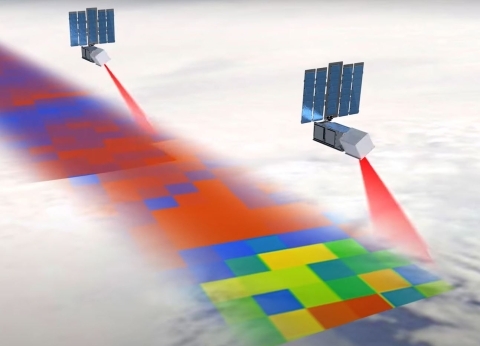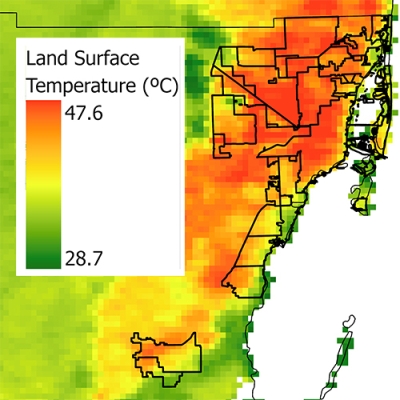NASA’s Goddard Earth Sciences Data and Information Services Center (GES DISC) has released a suite of provisional Pathfinder data products from the Time-Resolved Observations of Precipitation structure and storm Intensity with a Constellation of SmallSats (TROPICS) mission.
As its name implies, the aim of the TROPICS mission is to observe tropical cyclones via a constellation of small satellites (SmallSats) equipped with a high-performance microwave sounder—the TROPICS Millimeter-wave Sounder (TMS). This instrument features a variety of microwave bands that facilitate the study of water droplets (W-band), brightness temperatures (i.e., radiance, F-band), and moisture (G-band), and that provide frequent temperature and humidity profiles in all weather conditions.
Among the TROPICS-01 (Pathfinder), TROPICS-03, and TROPICS-06 data products released are:
- Level 1A Orbital Geolocated Native-Resolution Antenna Temperatures V0.2 (TROPICS03ANTTL1A)
- Level 1A Orbital Geolocated Native-Resolution Antenna Temperatures V0.2 (TROPICS06ANTTL1A)
These products provide geolocated antenna temperatures (radiance) in units of kelvins that are timestamped to Universal Coordinated Time (UTC) and are reported at native spatial resolutions
- Level 1B Brightness Temperature Product (TROPICS01BRTTL1B_1.0)
- Level 1B Orbital Geolocated Native-Resolution Brightness Temperatures V0.2 (TROPICS03BRTTL1B)
- Level 1B Orbital Geolocated Native-Resolution Brightness Temperatures V0.2 (TROPICS06BRTTL1B)
These products offer geolocated brightness temperatures (radiance) in units of kelvins that are timestamped to UTC and are reported at native spatial resolutions [Note: These are technically considered antenna temperatures, as no scan bias correction has been applied for this provisional release]
- Level 2A Unified Resolution Radiometric Product (TROPICS01URADL2A_1.0)
- Level 2A Unified Resolution Brightness Temperatures V0.2 (TROPICS03URADL2A)
- Level 2A Unified Resolution Brightness Temperatures V0.2 (TROPICS06URADL2A)
These products offer geolocated brightness temperature with the water vapor sounding channels converted from their native G-band resolution to the temperature sounding channel (F-band)
- Level 2B Instantaneous Surface Rain Rate Product (TROPICS01PRPSL2B_1.0)
This product offers retrievals of instantaneous surface rain rate in units of millimeters per hour at G-band spatial resolution; the algorithm was adapted from the NASA Goddard Precipitation Retrieval and Profiling Scheme
Each TROPICS netCDF file contains a granule of data (i.e., one orbit’s worth of data) with 81 spots and approximately 2,880 scans. The data maturity levels for TROPICS products will proceed through beta, provisional, validated stage 1, and validated stage 2, which is similar to that of the NASA Science Mission Directorate process. Individual products from each TROPICS SmallSat will go through these maturity levels; the status of the various Pathfinder data products can be found on the TROPICS Data Processing Center website.
Although existing polar-orbiting weather satellites can observe the characteristics of tropical storms and hurricanes once every few hours, this amount of observational frequency still leaves gaps in coverage during which storms may quickly strengthen. TROPICS, with its constellation of SmallSats, fills these gaps by providing near-hourly observations of storm precipitation, temperature, and humidity.
According to Dr. William Blackwell, a Fellow at the Massachusetts Institute of Technology’s Lincoln Laboratory and principal investigator (PI) of the TROPICS mission, these data will allow scientists to better understand drivers of storm intensification.
“Data from this mission will be available with unprecedented revisit rates for this kind of observation—one hour versus every four to six hours with present state-of-the-art technology,” Blackwell said. “These new data will capture storm dynamics that we hope will lead to better characterization and understanding of the interaction of the storms with their environment, ultimately leading, we hope, to improved forecasting of tropical cyclone track and intensity.”
Flying in three low-Earth orbital planes, the radiometers aboard the TROPICS SmallSats will scan across the entire satellite track at 30 revolutions per minute, providing atmospheric profiles of temperature and water vapor, atmospheric imagery, and precipitation and cloud ice measurements—data that can be used to study the thermodynamics of the troposphere and precipitation structure for storm systems throughout their lifecycles.
“This observing system offers an unprecedented combination of horizontal and temporal resolution to measure environmental and inner-core conditions for tropical cyclones on a nearly global scale,” Blackwell said. “[It] is a profound leap forward in the temporal resolution of several key parameters needed for detailed study of high-impact meteorological events.”
Located at NASA's Goddard Space Flight Center in Greenbelt, Maryland, GES DISC provides access to a wide range of global climate data, concentrated primarily in the areas of atmospheric composition, atmospheric dynamics, global precipitation, and solar irradiance. GES DISC supports data from many heritage and Earth Observing System (EOS) missions including Aqua, Aura, the Solar Radiation and Climate Experiment (SORCE), the Tropical Rainfall Measuring Mission (TRMM), the Upper Atmosphere Research Satellite (UARS), and the Total Ozone Mapping Spectrometer-Earth Probe (TOMS-EP). GES DISC also provides data subsetting, exploration, visualization, and access services.
Data Access
Users can access this suite of provisional TROPICS datasets using NASA’s Earthdata Search, through the GES DISC website, and by using the Open-source Project for a Network Data Access Protocol (OPeNDAP) service.

